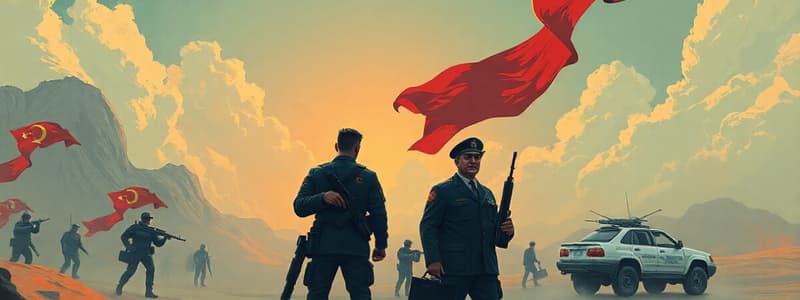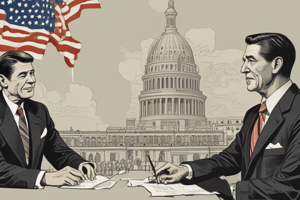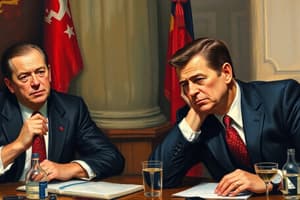Podcast
Questions and Answers
Which policy was primarily aimed at preventing the expansion of Soviet communism during the Cold War era?
Which policy was primarily aimed at preventing the expansion of Soviet communism during the Cold War era?
- Glasnost
- Perestroika
- Détente
- Containment (correct)
The demolition of the Berlin Wall in 1989 directly resulted in the immediate end of the Cold War.
The demolition of the Berlin Wall in 1989 directly resulted in the immediate end of the Cold War.
False (B)
How did the division of Berlin reflect the broader ideological conflict of the Cold War?
How did the division of Berlin reflect the broader ideological conflict of the Cold War?
Berlin was partitioned into West Berlin, controlled by the Western Allies, and East Berlin, controlled by the Soviet Union, symbolizing the divide between democracy and communism.
The 22nd Amendment to the U.S. Constitution formalized the ______ that presidents should only serve two terms.
The 22nd Amendment to the U.S. Constitution formalized the ______ that presidents should only serve two terms.
Match the branch of the U.S. government with its primary function:
Match the branch of the U.S. government with its primary function:
Which fundamental principle of American governance is designed to prevent any single branch of government from becoming too powerful?
Which fundamental principle of American governance is designed to prevent any single branch of government from becoming too powerful?
The U.S. Constitution originally mandated a two-term limit for presidents, a rule that was established from the nation's founding.
The U.S. Constitution originally mandated a two-term limit for presidents, a rule that was established from the nation's founding.
Briefly explain the significance of President Reagan's address at the Berlin Wall in 1987, including a key quote from his speech.
Briefly explain the significance of President Reagan's address at the Berlin Wall in 1987, including a key quote from his speech.
The concept of '______' ensures that each branch of the U.S. government can limit the powers of the other branches.
The concept of '______' ensures that each branch of the U.S. government can limit the powers of the other branches.
Match the following actions to the corresponding branch of the U.S. government that performs them:
Match the following actions to the corresponding branch of the U.S. government that performs them:
Which event most directly signaled the approaching end of the Cold War tensions in Europe?
Which event most directly signaled the approaching end of the Cold War tensions in Europe?
The primary reason for building the Berlin Wall was to prevent Western spies from infiltrating East Germany.
The primary reason for building the Berlin Wall was to prevent Western spies from infiltrating East Germany.
Describe the policy of 'containment' as it was applied during the Cold War. What were its main objectives?
Describe the policy of 'containment' as it was applied during the Cold War. What were its main objectives?
The ______ is composed of the Senate and the House of Representatives.
The ______ is composed of the Senate and the House of Representatives.
Match the branch of the U.S. government with its role in checking the power of the other branches:
Match the branch of the U.S. government with its role in checking the power of the other branches:
Flashcards
What was the Cold War?
What was the Cold War?
A period of geopolitical tension between the United States and the Soviet Union and their respective allies.
What is Containment?
What is Containment?
The policy of preventing the spread of communism.
What was the Berlin Wall?
What was the Berlin Wall?
A wall that divided Berlin from 1961 to 1989.
When did the Berlin Wall fall?
When did the Berlin Wall fall?
Signup and view all the flashcards
Who was Mikhail Gorbachev?
Who was Mikhail Gorbachev?
Signup and view all the flashcards
When did the Soviet Union dissolve?
When did the Soviet Union dissolve?
Signup and view all the flashcards
What is the Legislative Branch?
What is the Legislative Branch?
Signup and view all the flashcards
What is the Executive Branch?
What is the Executive Branch?
Signup and view all the flashcards
What is the Judicial Branch?
What is the Judicial Branch?
Signup and view all the flashcards
What are Checks and Balances?
What are Checks and Balances?
Signup and view all the flashcards
Why separation of powers?
Why separation of powers?
Signup and view all the flashcards
What is a Presidential Veto?
What is a Presidential Veto?
Signup and view all the flashcards
What is Overriding a Veto?
What is Overriding a Veto?
Signup and view all the flashcards
What is Judicial Review?
What is Judicial Review?
Signup and view all the flashcards
Who was Ronald Reagan?
Who was Ronald Reagan?
Signup and view all the flashcards
Study Notes
The 1980s
- The 1980s were a time of significant political events.
- President Reagan played a key role in ending the Cold War.
- President Reagan and Mikhail Gorbachev, the leader of the Soviet Union, engaged in peace talks, which reduced tension between the US and the Soviet Union.
Cold War Background
- The Cold War began at the conclusion of World War II.
- The US and the Soviet Union emerged as the world's strongest countries after the war.
- The US and the Soviet Union had opposing ideologies of US democracy vs Soviet communism.
- The US aimed to control communism through containment.
- Containment is defined as keeping something harmful under control or within limits.
- The "Cold War" title stems from the absence of direct military engagement between the two countries.
- The Cold War was a major part of the 20th century.
- By the close of the 1980s, the Cold War appeared to be nearing its end.
The Berlin Wall
- The Berlin Wall was a symbol of the Cold War.
- In 1945, following Germany's defeat, the country was divided into two parts.
- West Germany, also known as the Federal Republic of Germany, was under the control of Americans, British, and French in 1949.
- The Soviet Union controlled East Germany, also known as the German Democratic Republic in October 1949.
- Berlin, Germany’s capital, was divided in half, with West Germany and East Germany controlling differing sections.
- The physical location of Berlin was in East Germany.
- East Germany sought to prevent its citizens from traveling or escaping to West Germany.
- The East German government believed democracy would negatively influence its citizens.
- The border closed in 1952, restricting East Germans from leaving without government permission.
- In August 1961, the East German government built the Berlin Wall to prevent citizens from escaping.
- The wall symbolized the separation between communist and democratic countries in Europe.
- When the Berlin Wall went up, families become separated
- Some East Germans were killed while trying to escape to West Germany.
- In 1987, President Reagan called for Gorbachev to tear down the wall
- In 1989, the Berlin Wall fell.
- The fall of the Berlin Wall marked the end of a significant symbol of the divide between the US and Eastern Europe, but it was not the end of the Cold War.
End of the Cold War
- After several Soviet countries fought to leave, the Soviet Union officially dissolved in December 1991, marking the end of the Cold War.
- After serving two terms, President Reagan left office.
- On January 20, 1989, George H.W. Bush, Reagan's vice president, assumed office after winning the 1988 elections.
Presidential Term Limits
- Presidents were not always limited to two terms.
- Until 1951, with the 22nd Amendment, the two-term limit was a tradition that began with George Washington.
- Other Presidents followed George Washington's example.
- President FDR served more than two terms due to the disorder caused by the Great Depression and WWII.
- FDR is the only president who has served four terms.
Three Branches of US Government
- The presidency is one of the three branches of the US government.
- The Constitution is the supreme law of America, created post US founding.
- The Constitution established the three branches of government that exist today.
- The first branch of government is the Legislative Branch, which creates laws.
- The Legislative branch is composed of Congress, the Senate and the House of Representatives.
- The Executive Branch, which includes the president, vice president, and cabinet, is the second branch.
- The president’s cabinet, a group of special advisers chosen by the president.
- The executive branch carries out, or executes, laws.
- The Judicial branch is the third branch of government.
- The Judicial Branch includes the Supreme Court and other federal courts
- The judicial branch interprets laws.
- The three-branch system allows for the separation of powers.
- Following the American Revolution, the colonists rebelled against the English government and wanted to ensure the government would not be too powerful.
- A strong leader, like a president, is important, but they did not want the president to become like the King of England.
- The three branches of government and the separation of powers was established to stop the president or any other branch becoming too powerful.
- Each branch of government keeps the other branches from becoming too powerful
- This is accomplished through checks and balances.
- The Constitution gives each branch different duties and powers.
- No single branch can function without the others.
- Checks and balances allow the branches to ensure that others are acting consitutionally.
Example of Checks and Balances
- Congress has the ability to create bills, which become laws.
- The President can sign the bill into law, or veto it.
- If the president vetoes the bill, Congress can override this veto.
- The Supreme Court can declare the law unconstitutional, even if both Congress and the president agree to pass it.
- These checks and balances are part of what makes US government a democracy.
Studying That Suits You
Use AI to generate personalized quizzes and flashcards to suit your learning preferences.




